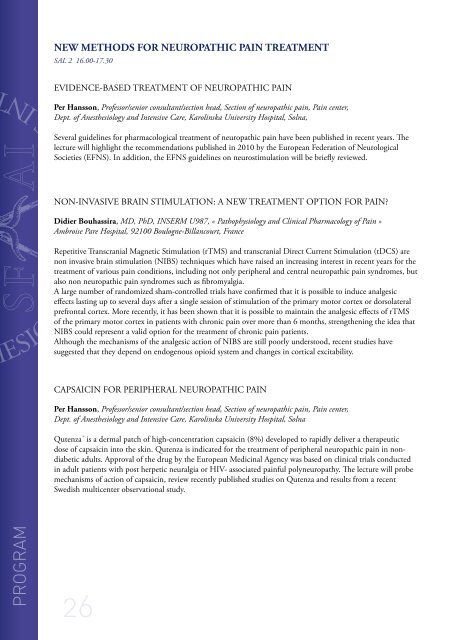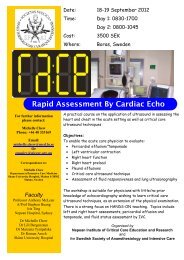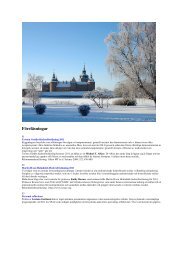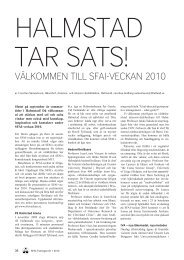Ladda ner den kompletta programboken här! - SFAI-veckan 2013
Ladda ner den kompletta programboken här! - SFAI-veckan 2013
Ladda ner den kompletta programboken här! - SFAI-veckan 2013
You also want an ePaper? Increase the reach of your titles
YUMPU automatically turns print PDFs into web optimized ePapers that Google loves.
NEW METHODS FOR NEUROPATHIC PAIN TREATMENT<br />
SAL 2 16.00-17.30<br />
EVIDENCE-BASED TREATMENT OF NEUROPATHIC PAIN<br />
Per Hansson, Professor/senior consultant/section head, Section of neuropathic pain, Pain center,<br />
Dept. of Anesthesiology and Intensive Care, Karolinska University Hospital, Solna,<br />
Several guidelines for pharmacological treatment of neuropathic pain have been published in recent years. The<br />
lecture will highlight the recommendations published in 2010 by the European Federation of Neurological<br />
Societies (EFNS). In addition, the EFNS guidelines on neurostimulation will be briefly reviewed.<br />
NON-INVASIVE BRAIN STIMULATION: A NEW TREATMENT OPTION FOR PAIN<br />
Didier Bouhassira, MD, PhD, INSERM U987, « Pathophysiology and Clinical Pharmacology of Pain »<br />
Ambroise Pare Hospital, 92100 Boulogne-Billancourt, France<br />
Repetitive Transcranial Magnetic Stimulation (rTMS) and transcranial Direct Current Stimulation (tDCS) are<br />
non invasive brain stimulation (NIBS) techniques which have raised an increasing interest in recent years for the<br />
treatment of various pain conditions, including not only peripheral and central neuropathic pain syndromes, but<br />
also non neuropathic pain syndromes such as fibromyalgia.<br />
A large number of randomized sham-controlled trials have confirmed that it is possible to induce analgesic<br />
effects lasting up to several days after a single session of stimulation of the primary motor cortex or dorsolateral<br />
prefrontal cortex. More recently, it has been shown that it is possible to maintain the analgesic effects of rTMS<br />
of the primary motor cortex in patients with chronic pain over more than 6 months, strengthening the idea that<br />
NIBS could represent a valid option for the treatment of chronic pain patients.<br />
Although the mechanisms of the analgesic action of NIBS are still poorly understood, recent studies have<br />
suggested that they depend on endogenous opioid system and changes in cortical excitability.<br />
CAPSAICIN FOR PERIPHERAL NEUROPATHIC PAIN<br />
Per Hansson, Professor/senior consultant/section head, Section of neuropathic pain, Pain center,<br />
Dept. of Anesthesiology and Intensive Care, Karolinska University Hospital, Solna<br />
Qutenza is a dermal patch of high-concentration capsaicin (8%) developed to rapidly deliver a therapeutic<br />
dose of capsaicin into the skin. Qutenza is indicated for the treatment of peripheral neuropathic pain in nondiabetic<br />
adults. Approval of the drug by the European Medicinal Agency was based on clinical trials conducted<br />
in adult patients with post herpetic neuralgia or HIV- associated painful polyneuropathy. The lecture will probe<br />
mechanisms of action of capsaicin, review recently published studies on Qutenza and results from a recent<br />
Swedish multicenter observational study.<br />
PROGRAM<br />
26





